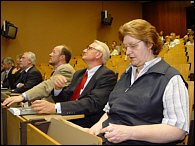
Doctoraatsverdediging
Nicole Pouliart
Shoulder instability.
Experimental model and related anatomy
Anterior shoulder instability is increasing in incidence
because the general population is becoming more  and more active. Many factors influencing the occurrence of a chronic
problem have been identified and many surgical solutions proposed. Nevertheless,
the recurrence rate after treatment remains relatively high. We believe
that experimental investigations leading to improved anatomic and biomechanical
knowledge are an important pathway for developing better treatment modalities.In
the first part of this thesis, we tried to develop and validate an experimental
model for anterior shoulder instability. In cadaver shoulders with an
intact muscular envelope, a series of sequential cutting experiments was
done. Lesions of the capsuloligamentous
and more active. Many factors influencing the occurrence of a chronic
problem have been identified and many surgical solutions proposed. Nevertheless,
the recurrence rate after treatment remains relatively high. We believe
that experimental investigations leading to improved anatomic and biomechanical
knowledge are an important pathway for developing better treatment modalities.In
the first part of this thesis, we tried to develop and validate an experimental
model for anterior shoulder instability. In cadaver shoulders with an
intact muscular envelope, a series of sequential cutting experiments was
done. Lesions of the capsuloligamentous  complex
were created at different locations of the joint and repeated in the presence
of rotator cuff lesions. The consequences for stability were evaluated
with five tests. An almost linear relationship between the extent of the
created damage and the ensuing degree of instability was found. The model,
however, was confronted with a few deviations from this covariability.
Because we had the feeling that these could be explained by anatomic factors
and because an exhaustive literature review failed to explain the aberrations,
we initiated the second part of the thesis. Here, a series of anatomic
and anatomo-clinical studies led to an expansion of the present anatomic
knowledge. In the course of these dissections, a new ligament - the posterosuperior
glenohumeral ligament - was discovered as well as an expanded role for
the tendon of the latissimus dorsi.
complex
were created at different locations of the joint and repeated in the presence
of rotator cuff lesions. The consequences for stability were evaluated
with five tests. An almost linear relationship between the extent of the
created damage and the ensuing degree of instability was found. The model,
however, was confronted with a few deviations from this covariability.
Because we had the feeling that these could be explained by anatomic factors
and because an exhaustive literature review failed to explain the aberrations,
we initiated the second part of the thesis. Here, a series of anatomic
and anatomo-clinical studies led to an expansion of the present anatomic
knowledge. In the course of these dissections, a new ligament - the posterosuperior
glenohumeral ligament - was discovered as well as an expanded role for
the tendon of the latissimus dorsi.
Terug naar doctoratenoverzicht
